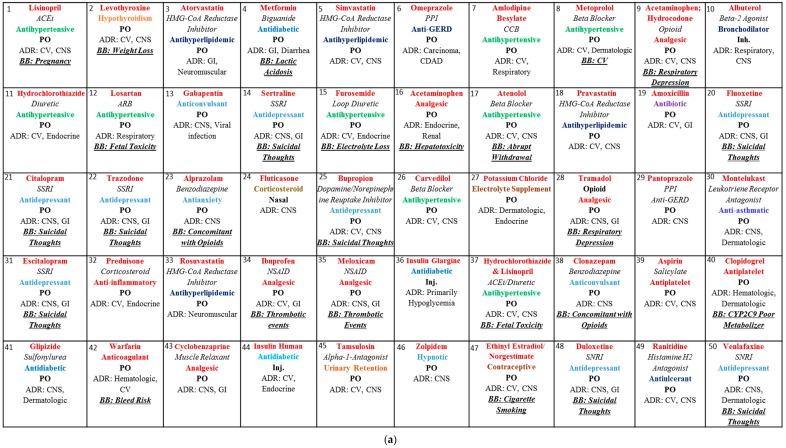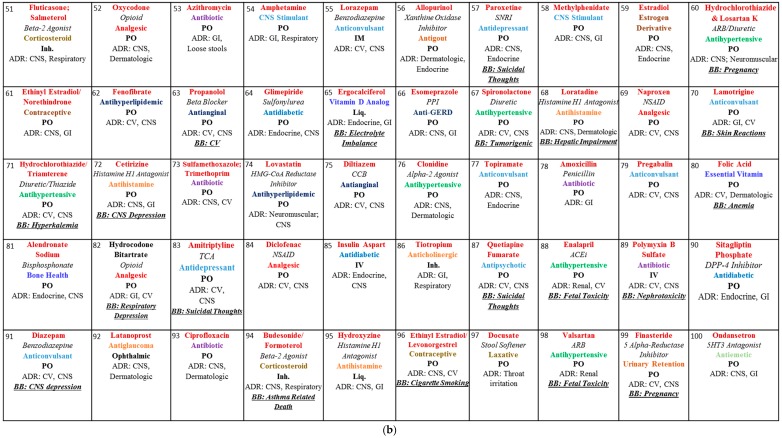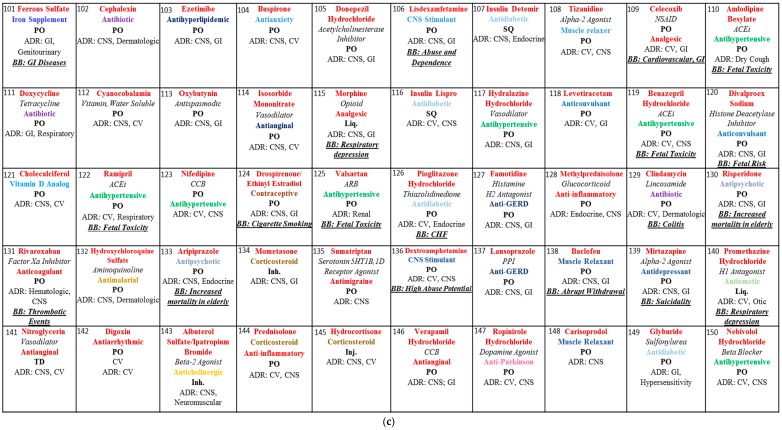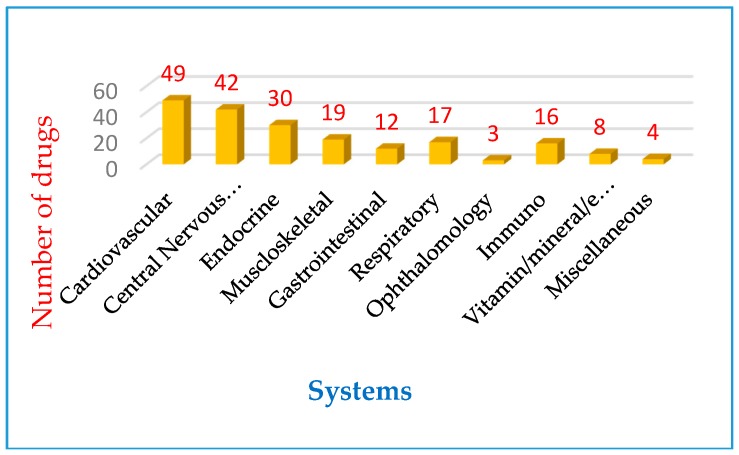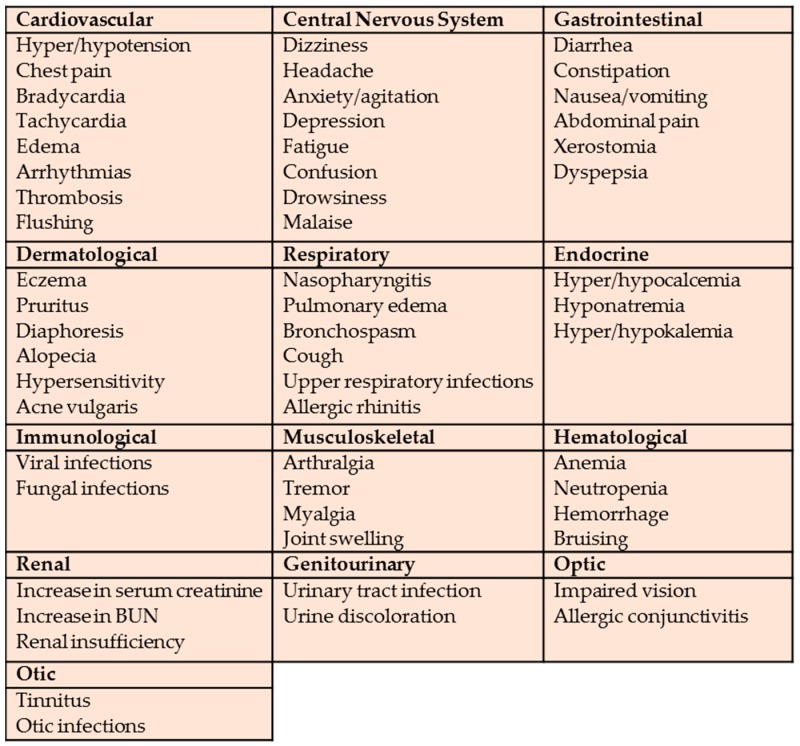Abstract
Pharmacists have access to a plethora of information related to drugs. Online compendia concerning top 200 prescribed drugs are readily-accessible, comparatively-easy to search. While these resources provide some information about the commonly prescribed drugs, they lack in furnishing in-depth knowledge to pharmacy students, pharmacists and other healthcare professionals. The aim of this paper is to present the relevant details of top 200 most prescribed drugs in the United States. The names and therapeutic classes of top 200 prescribed drugs were compiled from online resources. The pharmacological actions of drugs, any reported adverse reactions and black box warnings are collected from drug bank resources, such as AccessPharmacy and Lexicomp. The paper provides comprehensive information about top 200 prescribed drugs, which includes generic names, pharmacological action, route of administration and adverse reaction profile including black box warning when applicable. Overall, the drug list may serve as an easy access of ideas for pharmacists, researchers and other healthcare professionals interested in developing new strategies for treating patients with various ailments.
Keywords: black box warning, oral administration, cardiovascular, central nervous system, endocrine, gastrointestinal, antibiotics, antihypertensive, inhalers, biologics, nasal, injection
1. Introduction
Over the past few decades, the health care needs of our population changed along with the role of pharmacists [1]. Historically, pharmacists’ role in healthcare was centered on dispensing medications and ensuring the accurate delivery of medications to patients. In addition to allocating medications and safeguarding patient safety, today pharmacists are an integral part of our health care team and also are considered the most accessible health care professionals [2]. This approachability enables them to perform their pharmacists’ patient care process (PPCP), such as collect, access, plan, implement and follow-up to monitor and evaluate the appropriateness and effectiveness of medications and obtain patient feedback [3]. Additionally, pharmacists advise other health professionals concerning medication therapy decisions, the composition of drugs, their physicochemical and biological properties. Pharmacists also ensure the drug purity, efficacy, their interactions and side effects [4].
As per the survey conducted by National Pharmacist Workforce in 2014, over a decade pharmacists providing medication therapy management increased from 13% to 60% and those performing immunizations incremented from 15% to 53% respectively [5,6].
To deliver excellent pharmacy services to patients, pharmacists need to have complete knowledge of commonly prescribed drugs [7,8]. In 2014, the total number of prescriptions dispensed were approximately 4.325 billion, out of which the top 200 most prescribed drugs accounted for approximately 2.87 billion [9,10]. The top 200 drugs represent 66.6% (2/3) of total prescriptions filled in the US. The topic on top 200 most prescribed drugs in the US has been previously compiled in number of resources [11,12]. They offer a short comprehensive review of this topic [13,14]. However, in order to maximize studying, these guide/books/chapters, it is critical that a student has a firm grasp on the complete knowledge of the most commonly used medications [15]. This includes generic drugs as wells as mechanism of action (MOA), side effects, first line therapy indication, black box warning, and most common routes of administration. Therefore, the purpose of this article is to summarize the most commonly prescribed medications in the US and provide pharmacists and pharmacy students a resource before undertaking the task of practicing and studying for North American Pharmacist Licensure Examination (NAPLEX).
2. Materials and Methods
To accomplish the study objectives, this study was divided into two phases. Phase I consisted of gathering information on the drug names and therapeutic classes, which were compiled from the Clincalc.com. The Clinicalc.com website obtains its data annually from medical expenditure panel survey [MEPS] which is conducted by the US government [10]. Phase II entails collecting information on the drugs, their pharmacological actions, adverse reactions, and any possible black box warnings from resources, such as Clinical Drug Information from AccessPharmacy database on drug monographs and Lexicomp [16,17]. The prescribed drugs in the Figure 1a–d are numerically arranged based on the number of prescriptions filled and dispensed for each generic drug in the US. A set of inclusion and exclusion criteria was developed to select 200 commonly prescribed drugs. We included generic drugs obtained from the ClinCalc website, pharmacological actions and drug classes when applicable, most frequently used routes of administration, top two body systems affected by adverse drugs reactions, and the most advocated black box warming. Chemicals and biologics are included. The drugs not listed as top 200 drugs in the ClinCalc website were excluded. Additionally, if a drug is used in combination with another drug it is treated as a separate drug entity from the parent drug.
Figure 1.
(a) List of 1–50 most prescribed drugs; (b) List of 51–100 most prescribed drugs; (c) List of 101–150 most prescribed drugs; (d) List of 151–200 most prescribed drugs.
3. Results and Discussion
Top 200 most prescribed drugs shown in Figure 1a–d, were developed using the data obtained from Clincalc website. The individual drugs are represented by generic name, drug class (when applicable), pharmacological action, major route of administration, adverse drug reactions and any applicable black box warnings [BB]. The lists contain many blockbuster drugs of the last 10 to 15 years, such as atorvastatin, simvastatin, etc. The most prescribed drugs based on systems were cardiovascular (49), central nervous system (42), endocrine (30) and musculoskeletal (19). They accounted for approximately 140 drugs (70%) of top 200 most prescribed drugs. Drug utilization by systems is shown in Figure 2.
Figure 2.
Lists the number drugs prescribed for each system.
3.1. Blackbox Warning
As per FDA regulations any drug that may lead to adverse reactions and that might cause serious injury or result in death should be labeled by black box warning [18]. The number of drugs with black box warning are 81 drugs (40.5%) of 200 most prescribed medicines.
3.2. Dosage Forms
The lists also highlights the dosage forms of top 200 most prescribed drugs, they were oral, PO (166), inhalation, inh (7), intravenous, IV (3), intramuscular, IM (2), injections, inj (7), liquids, liq (4), subcutaneous, SQ (4), ophthamological, ophth (3), nasal, NAS (1), topical, TOP (1), transdermal, TM (1) and vaginal, VAG (1).
3.3. Biologicals and Chemicals
As per the lists, only 7 (3.5%) of drugs were biologicals among the top 200 most prescribed drugs, rest were chemical entities.
3.4. Opioids
Five opioids namely, acetaminophen/hydrocodone, tramadol, oxycodone, hydrocodone, and morphine are among the top 200 most prescribed drugs. In fact, Aacetaminophen/hydrocodone is 1 of the top 10 most prescribed drugs. Tramadol and oxycodone are listed among top 60 most prescribed drugs in the US.
3.5. Adverse Drug Reactions
Within top 200 drugs the most common ADRs and their range according to the systems are shown in Figure 3.
Figure 3.
The most common adverse drug reactions for top 200 drugs by systems
4. Conclusions
The visual language of the top 200 most prescribed drugs presented in the paper will foster long-term learning and enable students and residents to be more confident and competent before facing actual patients. Also will provide a quick reference about their therapeutic use, side effects, dosage forms and black box warning information of 66% of the total drugs prescribed in the US. Additionally, the drug lists will be handy for pharmacists, researchers and other healthcare professionals interested in developing new strategies for treating patients with various ailments.
Acknowledgments
We wish to acknowledge Melissa Santibanez for her critical analysis of our manuscript and Larkin University College of Pharmacy for providing access to Lexicomp and AccessPharmacy databases.
Abbreviations
| CV | Cardiovascular |
| GI | Gastrointestinal |
| IM | intramuscular |
| Opth | Ophthalmic |
| Inj | Injection |
| ADR | Adverse Drug Reaction |
| CNS | Central Nervous System |
| PO | Oral |
| IV | Intravenous |
| Inh | Inhalation |
| Liq | Liquid |
| BB | Black Box Warning |
| SQ | Subcutaneous |
| TD | Transdermal |
| CDAD | Clostridium Difficile Associated Diarrhea |
| GERD | Gastroesophageal Reflux Disease |
| ACEi | Angiotensin-Converting-Enzyme Inhibitor |
| ARB | Angiotensin II Receptor Blockers |
| HMG-CoA Reductase Inhibitor | 3-hydroxy-3-methyl-glutaryl-coenzyme A reductase Inhibitor |
| PPI | Proton Pump Inhibitor |
| CCB | Calcium Channel Blocker |
| SSRI | Selective Serotonin Reuptake Inhibitors |
| SNRI | Serotonin–Norepinephrine Reuptake Inhibitors |
| TCA | Tricyclic Antidepressant |
| NRI | Norepinephrine Reuptake Inhibitor |
| NSAID | Non-Steroidal Anti-Inflammatory Drug |
| SGLT2 Inhibitor | Sodium-Glucose co-Transporter-2 Inhibitor |
| DPP-4 Inhibitor | Dipeptidyl Peptidase-4 Inhibitor |
Author Contributions
K.C.N.V. conceived and designed the project; A.V.F. and M.D.P. performed the literature search and gathered the information; A.V.F. and K.C.N.V. analyzed the data; A.V.F. and K.C.N.V. wrote the paper.
Conflicts of Interest
The authors declare no conflict of interest.
References
- 1.Exploring Pharmacists’ Role in a Changing Healthcare Environment. [(accessed on 15 January 2018)]; Available online: https://www.nacds.org/pdfs/comm/2014/pharmacist-role.
- 2.Robert A.B., Michael L.A. The Role of the Pharmacist in Health Care Expanding and Evolving. N. C. Med. J. 2017;78:165–167. doi: 10.18043/ncm.78.3.165. [DOI] [PubMed] [Google Scholar]
- 3.The Pharmacists’ Patient Care Process. [(accessed on 15 March 2018)]; Available online: https://jcpp.net/patient-care-process.
- 4.Role of a Pharmacist. [(accessed on 12 February 2018)]; Available online: http://www.pharmcas.org/preparing-to-apply/about-pharmacy/role-of-a-pharmacist.
- 5.The Pharmacist’s Expanded Role. [(accessed on 12 February 2018)]; Available online: http://www.pharmacytimes.com/publications/issue /2015/october2015/the-pharmacists-expanded-role.
- 6.2014 National Pharmacist Workforce Survey. [(accessed on 1 March 2018)]; Available online: https://www.aacp.org/sites/default/files /finalreportofthenationalpharmacistworkforcestudy2014.
- 7.Winit-Watjana W., Francis D., Ho H.M. Top 200 Prescribed drugs as a tool for pharmacy teaching and training. Pharm. Educ. 2011;11:46–53. [Google Scholar]
- 8.Tanjung H.R., Nasution E.S. Top 200 Prescribed Drugs Mostly Prescribed by the Physician in Pharmacies at Medan City. IOP Conf. Ser. Mater. Sci. Eng. 2017;180:012037. doi: 10.1088/1757-899X/180/1/012037. [DOI] [Google Scholar]
- 9.Total Number of Medical Prescriptions Dispensed in the U.S. from 2009 to 2016. [(accessed on 18 March 2018)]; Available online: https://www.statista.com/statistics/238702/us-total-medical-prescriptions-issued.
- 10.The Top 200 Drugs of 2018. [(accessed on 1 March 2018)]; Available online: http://clincalc.com/DrugStats.
- 11.Evans C., Foushee L., Al-Achi A. Top 200 prescribed drugs learning tool and objective evaluation instruments in community pharmacy clerkship sites. J. Am. Pharm. Assoc. 2006;46:292–293. [Google Scholar]
- 12.Guerra T. The Top 200 Drugs of 2017. [(accessed on 15 February 2018)]; Available online: http://www.pharmacytimes.com/contributor/tony-guerra-pharmd/2017/03/the-top-200-drugs-of-2017.
- 13.Top 200 Drugs to Memorize. [(accessed on 18 January 2018)]; Available online: https://www.pharmacy-tech-test.com/top-200-drugs.html.
- 14.McGrath N.A., Brichacek M., Njardarson J.T. A Graphical Journey of Innovative Organic Architectures That Have Improved Our Lives. J. Chem. Educ. 2010;87:1348–1349. doi: 10.1021/ed1003806. [DOI] [Google Scholar]
- 15.Santee J. A Web-Based Practice Examination to Improve Student Performance Concerning the 200 Most Prescribed Drugs. Am. J. Pharm. Educ. 2003;67:102. doi: 10.5688/aj6704102. [DOI] [Google Scholar]
- 16.Access Pharmacy. [(accessed on 18 January 2018)]; Available online: http://accesspharmacy.mhmedical.com.
- 17.Lexicomp Online. [(accessed on 18 January 2018)]; Available online: http://online.lexi.com/crlsql/servlet/crlonline.
- 18.Boxed Warning. [(accessed on 18 January 2018)]; Available online: https://www.fda.gov/drugs/resourcesforyou/consumers /prescriptiondrugadvertising/ucm072025.htm#B.



